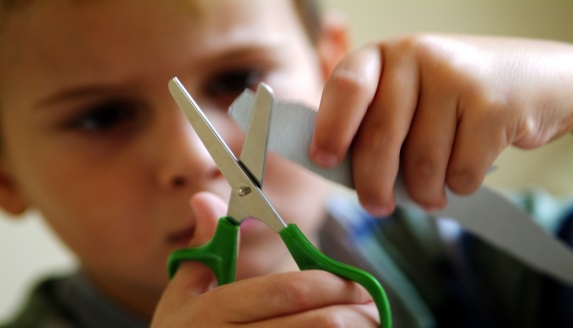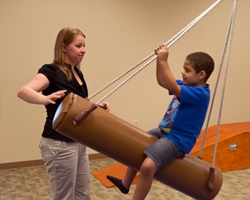What is Occupational Therapy? Celebrating OT Month
By Jessica Tallent, OTR/L
Kids Place Pediatric Occupational Therapist
Since 1980, the American Occupational Therapy Association (AOTA) has recognized April as occupational therapy month. But what exactly do occupational therapists, specifically pediatric occupational therapists, do?
The World Federation of Occupational Therapy (OT) defines occupational therapy as a “client-centered health profession concerned with promoting health and well-being through occupation.” The main goal of occupational therapy is to help people participate in everyday activities. Occupational therapists work with people and communities to “enhance their ability to engage in the occupations they want to, need to, or are expected to do, or by modifying the occupation or the environment to better support their occupational engagement” (WFOT 2012).
Simply, occupational therapists help people participate fully in life with activities of daily living. Occupational therapists work with a wide range of patients from pediatrics to geriatrics in the home, clinic, hospital, and school. Pediatric occupational therapists treat a wide range of diagnoses including but not limited to Autism, Down’s syndrome, Cerebral Palsy, Developmental Delays, Sensory Processing Disorders, and ADHD. We focus on improving function and independence for children and their families.
Below are four of the primary areas addressed by a pediatric occupational therapist:
1.  Activities of Daily Living (ADLs) – This is one of the primary focuses of OT as a profession. We aim to help our clients become as independent as possible in areas of self-care including dressing, bathing, grooming, eating, and cooking, to name a few. With children, we are often teaching these skills for the first time. Mastering these skills will take a lot of practice, time and patience as well as mastery of many of the foundational skills listed below.
Activities of Daily Living (ADLs) – This is one of the primary focuses of OT as a profession. We aim to help our clients become as independent as possible in areas of self-care including dressing, bathing, grooming, eating, and cooking, to name a few. With children, we are often teaching these skills for the first time. Mastering these skills will take a lot of practice, time and patience as well as mastery of many of the foundational skills listed below.
 2. Fine motor skills – Fine motor skills refer to the coordinated use of your hands and fingers for functional tasks. Some tasks requiring strong fine motor skills are buttoning, zipping, writing, opening a carton of milk, brushing your teeth, and tying your shoes.
2. Fine motor skills – Fine motor skills refer to the coordinated use of your hands and fingers for functional tasks. Some tasks requiring strong fine motor skills are buttoning, zipping, writing, opening a carton of milk, brushing your teeth, and tying your shoes.
 3. Visual motor skills – Visual motor skills involve integration of the visual system with motor movements. These skills are important for independence especially as a child reaches school age. It is crucial for reading, writing, and eye-hand coordination. If the visual system is impaired, balance, coordination, motor skills, learning and self-care are among the areas that could be affected.
3. Visual motor skills – Visual motor skills involve integration of the visual system with motor movements. These skills are important for independence especially as a child reaches school age. It is crucial for reading, writing, and eye-hand coordination. If the visual system is impaired, balance, coordination, motor skills, learning and self-care are among the areas that could be affected.
 4. Sensory processing – Sensory processing refers to a person’s ability to take information from the environment using their seven senses (sight, sound, taste, touch, smell, movement, and position) and interpret that information to make sense of the world. When any part of this system functions in an atypical way, the person struggles to make sense of their world, which can be a scary experience. Occupational therapy can work to improve sensory processing in our kids and improve their ability to participate fully in life.
4. Sensory processing – Sensory processing refers to a person’s ability to take information from the environment using their seven senses (sight, sound, taste, touch, smell, movement, and position) and interpret that information to make sense of the world. When any part of this system functions in an atypical way, the person struggles to make sense of their world, which can be a scary experience. Occupational therapy can work to improve sensory processing in our kids and improve their ability to participate fully in life.
If you are concerned with your child’s performance in any of these areas, speak with an occupational therapist or your pediatrician and consider an occupational therapy evaluation.
References:
http://www.wfot.org/aboutus/aboutoccupationaltherapy/definitionofoccupationaltherapy.aspx
http://www.aota.org/About-Occupational-Therapy/Patients-Clients.aspx
Case-Smith, J. (2004) Occupational Therapy for Children. Orlando, FL: Mosby Inc.








